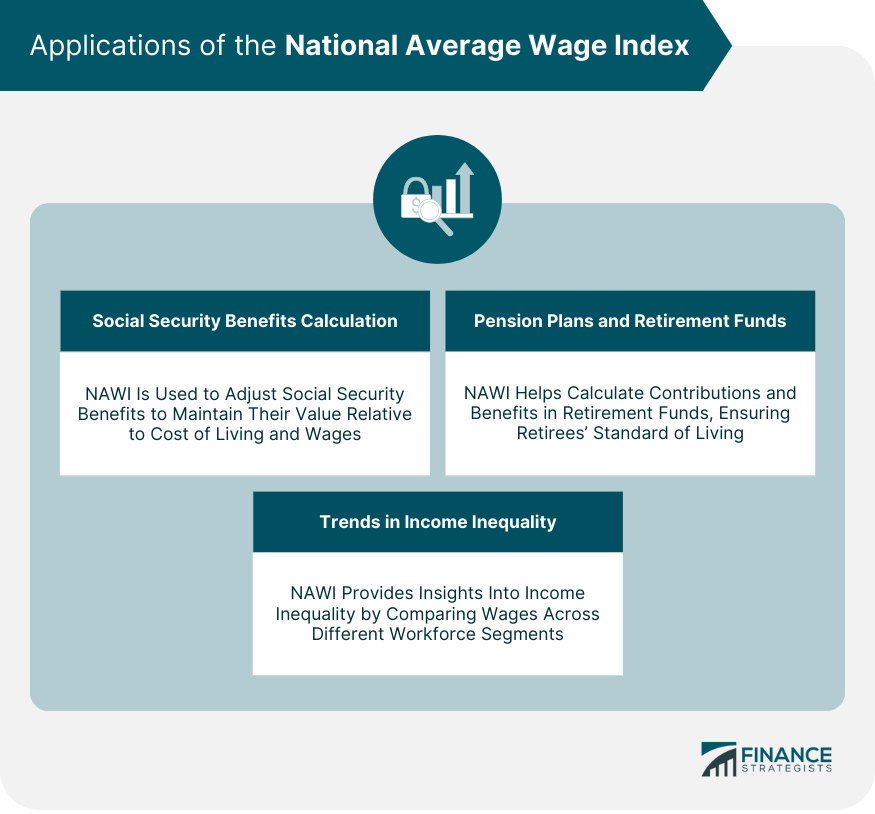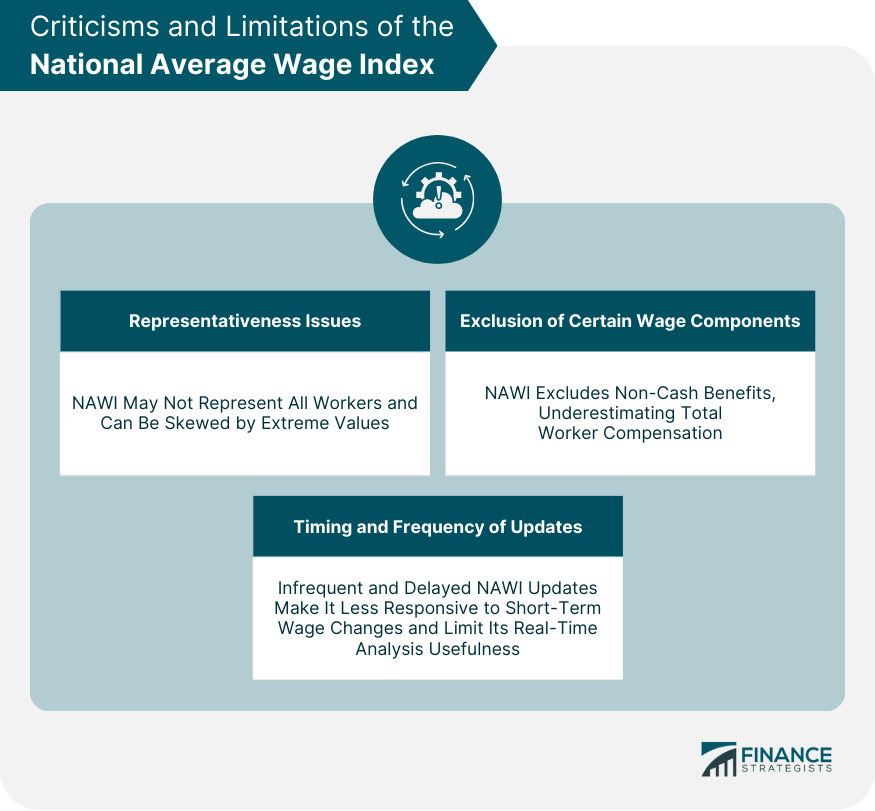The National Average Wage Index (NAWI) is a measure that captures the average annual wages of workers in a country. It is calculated by taking the total wages earned in a particular year and dividing it by the number of workers. NAWI serves as an important economic indicator that helps policymakers and economists monitor the wage trends, assess economic performance, and inform public policy. The concept of the National Average Wage Index originated in the United States during the 1970s, as a way to adjust Social Security benefits to keep up with inflation and wage growth. Since then, NAWI has become an essential tool for economists and researchers to study wage trends across time and compare the wage levels between different countries. NAWI plays a vital role in shaping public policy, informing retirement plans, and evaluating income distribution within a country. It is a key component in calculating Social Security benefits, pension plans, and determining eligibility for various social programs. Additionally, it helps economists and policymakers monitor and analyze the health of the labor market, overall economic performance, and trends in income inequality. The process of calculating the NAWI begins with collecting data on wages and the number of workers in a country. This information is typically obtained from multiple sources, such as payroll tax records, labor force surveys, and national income and product accounts. These sources provide comprehensive and up-to-date information on the total wages earned by workers and the number of employees in various industries. When calculating the NAWI, several components of wages are included, such as base salary, commissions, bonuses, and overtime pay. However, non-cash benefits like health insurance and retirement contributions are typically excluded. It's important to note that the specific components included in the calculation may vary from country to country, depending on the availability of data and the methodologies used. Once the data is collected and the wage components are defined, the NAWI can be calculated using a simple mathematical formula. The total wages earned by all workers in a given year is divided by the total number of workers to arrive at the National Average Wage Index for that year. Gross Domestic Product (GDP) per capita measures the economic output of a country divided by its population. While NAWI captures the average wage earned by workers, GDP per capita considers the overall wealth generated by an economy. Therefore, these two indicators provide different perspectives on a country's economic well-being, with NAWI focusing on wages and GDP per capita emphasizing total output. Average hourly earnings is another measure of worker compensation, calculated by dividing the total wages earned by the number of hours worked. Although both NAWI and average hourly earnings reflect worker compensation, they differ in terms of what they capture. NAWI considers annual wages, while average hourly earnings focus on the compensation received for each hour worked. As a result, NAWI is more suitable for examining trends over longer periods, while average hourly earnings provide insights into short-term fluctuations. The unemployment rate is the percentage of the labor force that is unemployed and actively seeking employment. While both NAWI and unemployment rates provide insights into labor market conditions, they are not directly correlated. A low unemployment rate might coincide with low NAWI if workers are employed in low-paying jobs, while a high unemployment rate may occur alongside high NAWI if the remaining employed workers are in high-paying roles. NAWI plays a crucial role in determining Social Security benefits. In the United States, for instance, the Social Security Administration uses the NAWI to adjust the benefits to keep up with the cost of living and wage growth. This ensures that the value of Social Security benefits does not erode over time due to inflation and wage increases. Retirement funds and pension plans often use the NAWI to calculate the contributions and benefits. It helps them to adjust the value of the pensions to match wage growth, ensuring that retirees maintain their standard of living. The NAWI can also provide insights into trends in income inequality. By comparing the NAWI with other wage indices, researchers can track how wages are changing across different segments of the workforce, providing a perspective on income inequality within a country. Economic recessions can significantly impact the NAWI. During recessions, unemployment rises, and wages tend to stagnate or even fall, leading to a decrease in the NAWI. However, the extent of the impact depends on the severity and duration of the recession. Inflation and changes in the cost of living can also influence the NAWI. If wages do not keep up with inflation, the purchasing power of workers decreases, leading to a decline in real wages and potentially the NAWI. Therefore, it is essential to consider inflation and changes in the cost of living when interpreting the NAWI. Changes in labor market conditions, such as shifts in the types of jobs available, changes in the demand for skills, and technological advancements, can also affect the NAWI. For instance, an increase in high-paying jobs or an upskilling of the labor force could lead to an increase in the NAWI. One of the main criticisms of the NAWI is that it may not fully represent all workers. Since it is an average, it can be skewed by extreme values. For instance, if a small number of workers earn extremely high wages, they can raise the average, masking the wages of typical workers. Another limitation is the exclusion of certain wage components, such as non-cash benefits. As a result, the NAWI might underestimate the total compensation received by workers, leading to an incomplete picture of worker compensation. The timing and frequency of updates can also limit the usefulness of the NAWI. In some countries, the NAWI is updated annually, making it less responsive to short-term changes in wages. Additionally, there may be a delay between the end of the year and when the NAWI for that year is published, which can limit its usefulness for real-time analysis. The National Average Wage Index (NAWI) is a vital economic indicator that captures the average annual wages of workers in a country. It serves as a valuable tool for policymakers and economists to monitor wage trends, assess economic performance, and inform public policy. With its origins in the United States, the NAWI has become widely used for studying wage trends over time and comparing wage levels between different countries. It plays a crucial role in shaping public policy, informing retirement plans, evaluating income distribution, and calculating benefits for social programs such as Social Security. Moreover, the NAWI provides insights into the health of the labor market, overall economic performance, and trends in income inequality. However, the NAWI is not without limitations. It may not fully represent all workers and can be skewed by extreme values, potentially masking the wages of typical workers. Certain wage components, such as non-cash benefits, are excluded from the calculation, leading to an incomplete picture of worker compensation. The timing and frequency of updates can also restrict the NAWI's usefulness, as it may be less responsive to short-term changes in wages and suffer from delays in publication. Despite these limitations, the NAWI remains a critical tool for understanding wage dynamics and informing various aspects of economic policy and decision-making. To fully understand a country's economic well-being and the conditions faced by its workers, it is essential to consider a range of economic indicators, including GDP per capita, unemployment rates, and inflation rates. By doing so, individuals can gain a more comprehensive understanding of a country's economic performance.What Is the National Average Wage Index (NAWI)?
Calculation of NAWI
Data Collection Methods
Wage Components Included
Mathematical Formulas
Comparing NAWI to Other Economic Indicators
Differences Between NAWI and GDP per Capita
Comparison to Average Hourly Earnings
Relationship With Unemployment Rates
Applications of the National Average Wage Index
Social Security Benefits Calculation
Pension Plans and Retirement Funds
Trends in Income Inequality

Fluctuations in the National Average Wage Index
Impact of Economic Recessions
Effect of Inflation and Cost of Living
Role of Changes in Labor Market Conditions
Criticisms and Limitations of the NAWI
Representativeness Issues
Exclusion of Certain Wage Components
Timing and Frequency of Updates

Final Thoughts
National Average Wage Index (NAWI) FAQs
The NAWI is a measure of the average annual wages earned by workers in a country. It is calculated by dividing the total wages earned in a given year by the number of workers.
The NAWI is calculated by collecting data on wages and the number of workers from various sources, defining the components of wages to be included, and then using a mathematical formula to calculate the index.
While the NAWI measures the average wage earned by workers, GDP per capita measures the total economic output of a country divided by its population. Therefore, these two indicators provide different perspectives on a country's economic well-being.
In many countries, including the United States, the NAWI is used to adjust Social Security benefits to keep up with inflation and wage growth.
Some criticisms of the NAWI include representativeness issues, the exclusion of certain wage components, and the timing and frequency of updates.
True Tamplin is a published author, public speaker, CEO of UpDigital, and founder of Finance Strategists.
True is a Certified Educator in Personal Finance (CEPF®), author of The Handy Financial Ratios Guide, a member of the Society for Advancing Business Editing and Writing, contributes to his financial education site, Finance Strategists, and has spoken to various financial communities such as the CFA Institute, as well as university students like his Alma mater, Biola University, where he received a bachelor of science in business and data analytics.
To learn more about True, visit his personal website or view his author profiles on Amazon, Nasdaq and Forbes.











